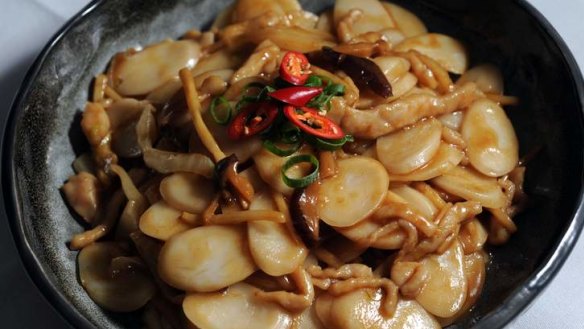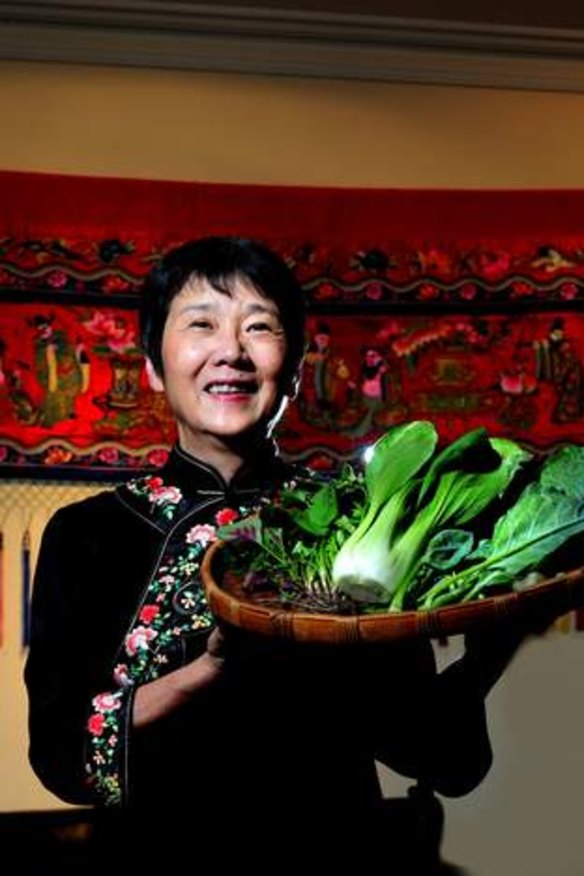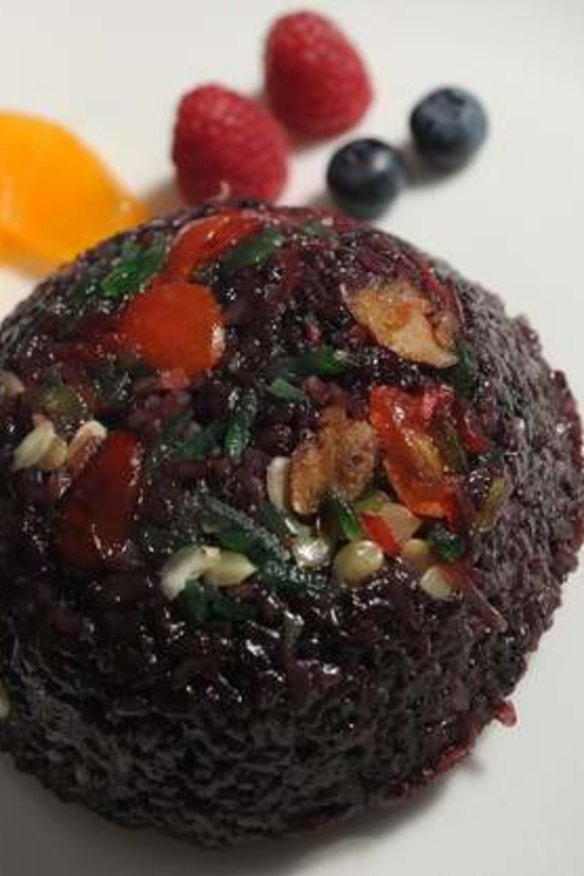Lashings of good omen
The right food at Chinese New Year can set you up for the year.

Food is the centrepiece at Chinese New Year not only for the way it brings families together but because it can set you up for good luck, good health and good fortune all year.
''Chinese people in a way are very superstitious,'' Canberra homecook Patty Yang says, "The Chinese like to give their food names with good omens. Usually if you go to Chinatown in Sydney you can hardly work out the content of a dish from the [symbolic] name.''
Yang has share a bok choy recipe for new year (overleaf). It contains two kinds of mushrooms, which lend the dish its prosperity-predicting name, ''gold and jade full house'', plus corn, which she adds for its gold colour. Another dish from Yang, called ru yi chai, or ''as you wish'', is at goodfood.com.au

Yang is from Taiwan, moving to Canberra 40 years ago, and says Chinese New Year was always the biggest annual celebration until more recently as her Australian-born children have grown up and left home. Now, they are more inclined to celebrate Christmas and eat roast turkey.
When her children were little, she would decorate her home with rich embroidery and red silk. An important tradition was giving them a red envelope with cash inside - and she says in Taiwan, where her father was a businessman, her family prepared stacks of envelopes for people who worked for and helped them. For luck, they would eat a dish called ho see fa cai, a dish of braised dried oysters and soaked black moss - the words ho see (oysters) and fa cai (hair seaweed) sounding similar to the Chinese phrase for ''wealth and good business''.
Now, Yang makes sweet, sticky rice cakes. Her mother used to say that the soft brown sugar in them would bring a rich, sweet life.

She serves a lighter cake alongside, made with white sugar, and steamed until they are well risen. Together, the brown and white cakes represent gold and silver - signs of prosperity at a time of year when the Chinese pray for wealth and luck.
A widely served dish is poached, whole fish, served with the head and tail intact, symbolising a good beginning and end to the year. As the word for ''fish'' in Mandarin sounds like the word for ''abundance'', eating this dish is said to bring abundance and excess through the year.
Glossy tangerines offered to visitors are said to represent wealth and good luck, and the circular shape of glutinous rice balls, tangyuan, imply family reunion.
Zhou ''Joe'' Chen is a chef who taught Asian and Western cooking at the Canberra Institute of Technology and now works for the Restaurant and Catering Association. He says new year feasts are ''some of the happiest memories of my childhood''. His family reunites at a long line of heavily laden tables, bringing dishes from different regions of China.
"For Chinese New Year, there will be five to six tables full of food. It really is a banquet - there's around eight entrees of slowpoached seafood, pork, chicken and vegetarian dishes, followed by about six main courses and then two sweet desserts," he says.
The feast is not complete without tangyuan, the sweet rice balls, which are filled with sesame, peanut or sweet bean
paste, cooked in boiling water and served in the resulting broth.
"There are many different aunties and uncles and each will bring one or two dishes. My grandparents grew up in different regions so there can be lots of different flavourings that have been passed down through the generations," he says, pointing to the light, mild Cantonese fare of Guangdong and Fujiang provinces and the sweet soy-based Hu cuisine found in Shanghai.
One food, though, must be avoided. "We don't eat tofu, as it is considered unlucky," Chen says. "Tofu is usually eaten during a funeral, therefore it is avoided during Chinese New Year." In Chinese culture, white represents blankness. So white foods and white clothing are avoided during the new year.
Chen says that ingredients for the celebratory dishes are easy to come by in Canberra. He shops at Asian grocery stores in the city and Belconnen, at Indian spice stores in Phillip and at the Fyshwick markets. "We love eating mud crab cooked with ginger and chilli. I'll usually buy it from the seafood markets," he says. "Or I'll cook barramundi with shallots." Chen shares a recipe for dumplings, at goodfood.com.au.
If you're not keen on the prep time for a homecooked meal, local Chinese restaurants including Wild Duck on the Kingston foreshore and Ruby in Dickson have special menus on offer.
Wild Duck owner Shan Gao grew up in China and came to Australia as a teenager. "My most memorable dish from China would be dumplings,'' he says. ''We'd let off fireworks at midnight and all go to bed for a while, waking up around 4.30am. I remember that my parents and grandparents would already be awake at this time, preparing the family banquet.
"As kids, the first thing we'd do is put on brand new clothes, then sit down to a bowl of dumplings. Dumplings signify "out with the old, in with the new" and are usually accompanied with a red envelope with money inside. This is known as lucky money." Gao says the chefs will have some fun with the traditional recipes at the Wild Duck banquet, offered February 6 (tonight) to 8.
"The idea is that we'll serve food that is similar to what we'd eat in China, if we were celebrating there," Gao says. The menu includes Beijing pork belly, smoked Shanghai fish fillet, and nian gao, a stir-fry of sliced rice cake and shiitake mushrooms (the recipe is on page 3). "Nian gao refers to the rice cake used as part of the ingredients. It represents two things, firstly ''going higher'', because when the word is pronounced it sounds similar to another word that means going higher," Gao says. "Literally, nian means year and gao means cake. Hence, it's a new year cake that represents going better and better as the year goes by." Wild Duck will also offer ''eight-treasure pudding'', using black glutinous rice and red bean paste, the pudding steamed in a basin (the recipe is at goodfood.com.au).
Ruby has three New Year banquets, offering dishes such as suckling pig and jellyfish, sea cucumber with duck feet and stir-fried pearl abalone. Manager Susie Chan says the symbolic names are an essential part of the celebration for the older generation. A dish called golden treasures contains abalone, sea cucumber, scallops, king prawns, fish maw and enoki mushrooms, and symbolises wealth.
''These ingredients have been used for a long time and they used to be quite expensive. Therefore when you eat it, you will find lots of little treasures and that means more money,'' she says. ''Everybody wants more money at the new year.''
It is a sentiment that also shows in the braised pig trotters. ''The trotters are like hands. They are like hands full of money,'' Chan says.
But Chan draws the line at one type of food. ''You won't see a lot of beef on our Chinese New Year menu, as it is a meat that is not commonly served during this time. Back in the old days, cows worked in the field and were valuable partners. You don't kill your partner, so that's why you will see more poultry, pork and seafood on the table.''
Estelle Griepink is a Canberra Times intern.
Gold and jade full house
Leave the mushrooms whole as the round shape symbolises reunion.
2 tbsp vegetable oil
2 cloves of garlic, crushed
10 to 12 medium button mushrooms
5 medium shiitake mushrooms (fresh, or dried and soaked)
1/2 cup sweet corn kernels (from a can or cut from a cob)
1 1/2 tbsp oyster sauce or to taste
1 bunch bok choy, cut lengthways into quarters
Heat the oil in a wok. Fry the garlic until fragrant and lightly coloured, then add the button mushrooms and stir-fry for two minutes. Add the shiitake mushrooms and the corn and fry another two minutes. Add the oyster sauce and a little water (if needed) and mix through. Check the seasoning and adjust to taste.
Plunge the bok choy briefly into rapidly boiling water to cook. Drain and arrange on a serving plate. Tip the mushrooms and sweet corn mixture on to the bok choy to serve.
Recipe from Patty Yang.
Ru yi chai - as you wish
A New Year dish to make wishes come true.
2 tbsp vegetable oil
2 spring onions cut into 5cm lengths
1 thumb-sized piece of ginger, finely julienned
1 carrot, julienned
3 tbsp peas
1/2 yellow pepper (capsicum), sliced
1/2 red pepper (capsicum), sliced
2 dried shiitake mushrooms, soaked and sliced
3 squares of pressed bean curd, sliced
sea salt
chicken stock powder (Knorr brand) or fish sauce to taste
1 rice bowl of mung bean sprouts (rinsed)
3 tsp sesame oil
Heat the wok and add the oil. Fry the spring onion and ginger briefly and then add the vegetables, shiitake and bean curd, but not the bean sprouts at this stage. Season the mixture with salt and add chicken stock powder or fish sauce to taste and stir-fry for a couple of minutes. Now add the bean sprouts and fry for a further 30 seconds. Stir in the sesame oil to finish and serve.
Recipe from Patty Yang, Canberra.
Crispy jiaozhi with chilli sauce - dumplings
Makes 48 dumplings
48 thin round jiaozhi pastry skins (see below for a recipe, or buy from most Asian grocers, will be marked ‘‘jiaozhi’’ or ‘‘gao zhi’’)
100g cabbage, finely chopped
100g Chinese cabbage, finely chopped
100g garlic chives, finely chopped
1 tsp salt
200g prawn meat, washed, dried, diced
2 tbsp pork fat
1 tsp chicken stock mixed with 1/2 cup hot water
1/2 tsp sesame oil
15g fresh ginger, finely grated
50g spring onions, finely chopped
salt and pepper
2 tbsp potato starch, plus 3 tbsp extra (available from most Asian groceries)
2 tbsp vegetable oil
To make your own dumpling wrappers, mix 250g of plain flour with 250ml of boiling water in a mixer until it becomes a smooth dough. Cover with cling wrap for 15 minutes. Roll into a long roll. Cut into 15 gram portions and roll each into a thin, round pastry.
To make the filling, finely chopped the two types of cabbage and the garlic chives. Mix in half a teaspoon of salt and set aside for 20 minutes. Then squeeze the mixture to remove excess water. Add the prawn meat and lard to the mixture, then the sesame oil, ginger, spring onions and two tablespoons of potato starch and seasoning. Mix well.
Place a spoonful of stuffing on to each pastry skin. Wet the edges of the skin with water and pleat them to seal. Dust the base of each dumpling with the extra potato starch, which will make the base of the dumplings more crispy.
Heat a small quantity of oil in a large non-stick frying pan. Fry the dumplings on medium heat until the bases turn golden brown. Add sufficient warm water to come about a third of the way up the dumplings. Cover and cook over medium heat for three to four minutes, until the water has reduced. Remove the lid and cook until all the water is evaporated and the bottom of the dumplings becomes crispy.
Serve with the dipping sauce (below).
Dipping sauce
50ml Kikkoman soy sauce
60ml rice vinegar
1 tbsp finely chopped spring onions
1/2 tbsp grated garlic
¼ tsp Szechuan pepper, roast and grind (available from most Asian groceries)
5ml red chilli oil
1 tbsp sugar
50ml water
Mix the ingredients together.
Recipe from Canberra chef Zhou Chen.
Eight-treasure pudding
Serves 3-4
This is a Chinese New Year celebration pudding.
120g black glutinous rice (available from most Asian groceries)
100g red bean paste (available in cans or bags, pre-sweetened)
15g sunflower, pumpkin and watermelon seeds, mixed
6 cooked lotus flower seeds (available from most Asian groceries)
1 Chinese date (available from most Asian groceries)
25g dried apricots
50g castor sugar
1 tbsp olive oil
Soak the rice in cold water for two hours then steam in bamboo steamer soft and sticky – about 20 minutes. While the rice is still warm mix in the sugar and olive oil.
Grease a ceramic bowl with oil and place the fruit, seeds and date in the bottom. Fill with half the rice and flatten to a level surface with enough pressure to ensure the seeds and fruit stick to the cake. Add the red bean past in three spots on this layer of rice, leaving sufficient space between each spot so the next layer of rice can stick to the bottom layer. Add the remaining rice and flatten with pressure until firm to touch.
Steam the cake for 10-15 minutes in a bamboo steamer the remove. Turn the bowl upside down on a plate and tap until cake comes out. Serve warm.
Recipe from the Wild Duck restaurant, Kingston foreshore.
Nian gao stir-fry
Serves 2
200g plain sliced rice cake (made from steamed ground white glutinous rice, available from Asian grocers; can be bought pre-sliced)
140g pork fillet
80g wombok (Chinese cabbage)
2 whole fresh shiitake mushrooms
30g canned bamboo shoots (either sliced or whole)
1 small clove garlic
2 tbsp vegetable oil
¾⁄ cup chicken stock
1 tbsp oyster sauce
1 tbsp light soy sauce
1 spring onion
Soak the rice cake slices in cold water for two hours then drain. Slice the pork fillet, cabbage, shiitake and bamboo shoots into similar size strips. Finely chop the garlic.
Heat the oil in a wok or large frypan. When hot, add the garlic and pork, fry until almost cooked, then add the remaining vegetables. Continue to stir-fry for one minute, adding the rice cake, chicken stock, oyster sauce and soy sauce. Turn the heat down. Mix well and continue to cook until the rice cake slices are tender - about three to five minutes. Garnish with sliced spring onion.
Recipe from the Wild Duck restaurant, Kingston foreshore.
Restaurant reviews, news and the hottest openings served to your inbox.
Sign up